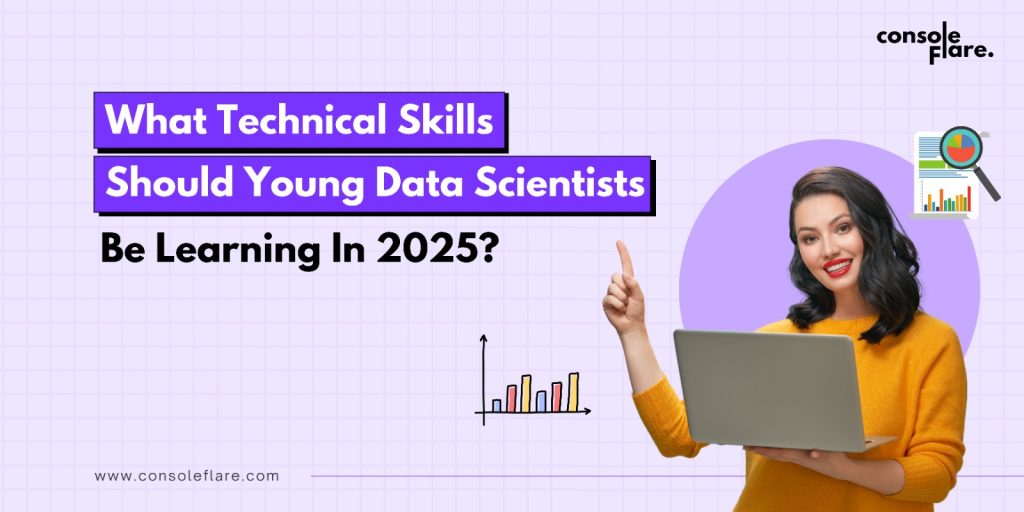Data science is one of the most lucrative and exciting career paths today. It blends curiosity, logic, creativity, and problem-solving into one powerful discipline. The best part? You don’t need to come from a tech background to get started—anyone with the right learning attitude can become a data scientist.
So, if you’re asking yourself, “What technical skills should I start with?”—this guide will break it down step by step.
9 Technical Skills Young Data Scientists Should Learn in 2026
1. Python: The Must-Know Programming Language
Python is the first programming language every aspiring data scientist should learn. Why?
- It’s beginner-friendly.
- It has a massive community and resources.
- It supports powerful libraries for data science.
With Python, you can build applications to collect, clean, analyze, and visualize data.
Start with basics:
- Writing conditions (if/else) and loops.
- Using lists, dictionaries, and variables for data management.
- Reading and writing files.
Essential libraries:
- NumPy → numerical computing.
- Pandas → data manipulation and wrangling.
- Matplotlib/Seaborn → data visualization.
If you’re new, just learning one hour a day can set you on the right path.
2. Data Handling with Pandas, CSV, and Excel
Data in the real world is messy and unstructured. A good data scientist knows how to make sense of it.
Start with spreadsheets (Google Sheets/Excel):
- Use formulas like SUM, IF, VLOOKUP.
- Sort, filter, and clean data.
- Create pivot tables and basic charts.
Then move to Pandas (Python):
- Read and clean CSV files.
- Handle missing values.
- Merge and split datasets.
- Create new columns using logic.
- Group and aggregate data.
Most real-world data science projects involve lots of time cleaning and preparing data, so this skill is essential.
3. Math & Statistics: The Logic Behind the Data
You don’t need to be a math genius, but you do need a solid grasp of key concepts to interpret data confidently.
Important topics:
- Mean, median, and mode.
- Variance and standard deviation.
- Probability distributions.
- Correlation vs. causation.
- Hypothesis testing.
These technical skills help answer questions like: “Is this trend real, or just luck?”
4. Databases & SQL
Most organizations store data in databases, and Structured Query Language (SQL) is how you access it.
With SQL you can:
- Query specific data from large tables.
- Apply filters (e.g., only Indian customers).
- Join multiple tables together.
- Perform aggregations (like total sales by city).
Example query:
SELECT city, SUM(sales)
FROM orders
GROUP BY city;
One line of SQL can give you powerful insights.
5. Data Visualization: Telling Stories with Data
Data is only valuable when others can understand it. That’s where visualization comes in.
Tools to start with:
- Excel/Google Sheets → quick bar, pie, and line charts.
- Tableau / Power BI → drag-and-drop dashboards.
- Matplotlib / Seaborn (Python) → custom plots inside code.
Always focus on clarity over complexity—a good chart should answer a business question instantly.
6. Basics of Machine Learning
Once you’ve mastered Python, data handling, and statistics, you can move on to machine learning (ML).
Start simple with supervised learning:
- Linear regression → predict numbers (e.g., house prices).
- Logistic regression → classify categories (e.g., pass/fail).
- Decision trees & random forests → structured predictions.
Explore unsupervised learning:
- Clustering (k-means, hierarchical).
- Dimensionality reduction (PCA, t-SNE).
Use Python’s Scikit-learn to practice building ML models.
7. Git & GitHub: Version Control for Projects
Data science is collaborative, and Git helps you:
- Track changes in your code.
- Work with teams smoothly.
- Showcase your portfolio on GitHub.
Even if you work solo, Git is an industry-standard skill.
8. Web Scraping & APIs
Sometimes, the data you need isn’t neatly packaged—it’s on websites.
- Web scraping → extracting data from web pages using tools like BeautifulSoup or Selenium.
- APIs → requesting structured data directly from platforms (Twitter, Spotify, weather services).
These technical skills give you real-time data access for projects.
9. Big Data & Cloud Tools (Optional but Future-Proof)
As data grows, companies rely on cloud platforms:
- AWS (Amazon Web Services)
- Google Cloud Platform (GCP)
- Microsoft Azure
For massive datasets, tools like Apache Spark and Hadoop are used.
Not mandatory for beginners, but having exposure can future-proof your career.
Conclusion
Becoming a data scientist doesn’t happen overnight. It’s about continuous learning and curiosity. Start with the core technical skills including Python, SQL, statistics, and data visualization. Then expand into ML, Git, APIs, and cloud tools as you progress.
If you’re serious about building a data science career, platforms like Console Flare can guide you with structured learning, hands-on projects, and placement support to land a high-paying role.
For more such content and regular updates, follow us on Facebook, Instagram, LinkedIn

